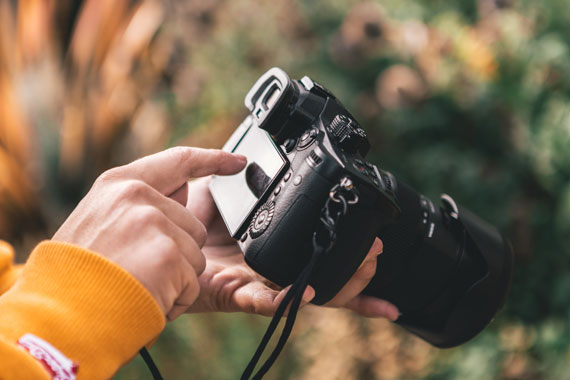Low resolution photos may look great on your monitor at “screen resolution”(72 ppi or pixels per inch). The small file size downloads fast and is easy to share online. Plus, you can get a lot of these images on a memory card.
But photos taken on a camera’s ‘basic’ or ‘low’ quality settings don’t cut it when you want professional quality images for print publication. With some exceptions, a resolution of 300 ppi is considered the minimum quality standard for printing photos. More on that in a moment. But first…

Photo captured by James Baldwin
Some Definitions
pixel: smallest unit of measurement in a digital image. Pixels are typically square and make up a grid the height and width of your image. Measured in microns (1/1000 of a millimeter or about 1/25,000 inch). Image sensors in most consumer cameras have pixels 4 to 5 microns square.
ppi: pixels per inch. How resolution is measured for your “capture” or “input” devices (camera, scanner) and your computer monitor.
dpi: dots per inch. How resolution is measured for your home/office printer which outputs your image in round dots, not square pixels.
lpi: lines per inch. How resolution is measured for offset presses. Newspapers generally print at 100 lpi and require 200 ppi images for quality reproduction. Magazines use a 150 lpi linescreen (300 dpi images) and art books and exhibition prints are printed at 200 lpi (400 ppi images). The rule of thumb is to print images at a dpi that’s double the lpi.
megapixel: one million pixels. How the resolution of digital cameras is measured. The larger the megapixel rating, the more information you can capture within an image and the larger you can print that image, maintaining high quality.
resolution: level of detail attainable by a monitor or a printer, determined by the ppi, dpi or lpi. When capturing images for printing, the higher the resolution, the greater the detail (up to a point) and the larger the file size. Quality may also be affected by the lens capturing the image, the camera’s ability to process the image, and the grain and size of a scanned original.
pixelization: the jagged stairstep effect you see on a low resolution image printed larger than optimal for its file size.
file size: how many kilobytes (k) or megabytes (mb) of information in a file. Determined by the resolution and physical size of an image. Relevant for screen display and printing of images as well as storing and transferring of files.
compression: how much of the potential information in an image file is discarded to keep file size down. Saving a photo in.jpg format allows you to choose a compression level, depending on whether better quality image or smaller file size is more important for your purposes.

Photo by Thomas Hawk; ISO 3200, f/2.0, 1/200-second exposure.
Print Quality Resolution
If you’re shooting for print output, capture your images at the highest quality setting your camera offers: RAW, High, Best, Fine, or whatever your system calls it. This captures the shot using the lowest compression ratio or no compression at all. You can always re-sample down (from more resolution to less) but if you interpolate up, you lose information and therefore image quality.
Shooting at high resolution may also give you the option of cropping and enlarging a portion of your image later, retaining enough data for a quality print, even after tossing some pixels to the cutting room floor. You won’t get as many images on your camera’s memory card shooting at high-res but you can keep your creative options open by archiving your ‘keepers’ on CD or a back-up drive. Your future self will thank you.
As mentioned, the industry standard resolution for quality photo output (offset press, digital, or inkjet) is 300 ppi. However, you may be able to get away with a ppi as low as 200 if the image is not too finely detailed, if it will be printed on low quality paper such as newsprint, or if it will be viewed from a distance.
The following formula can help you calculate:
- How large a print you can make from a digital image with a given set of pixel dimensions and a given resolution (ppi)
- What resolution a digital print will have printed at given output dimensions from a file with given pixel dimensions
- What dimensions–in pixels–your digital image will have captured at given dimensions in inches and at a given resolution
The Formula:
Divide each dimension of your digital image (in pixels) by the print resolution desired (in pixels per inch). This will give you the largest print size (in inches) you can generate at that resolution.
Example: (1500 pixels / 300 ppi) x (2100 pixels / 300 ppi) = 5″ x 7″.
To capture an image of this physical size at this resolution, you would need a 3 megapixel (MP) camera:
1500 pixels x 2100 pixels = 3,150,000 pixels or approximately 3 megapixels
A 1 megapixel camera will yield a 3 x 5″ print at 300 pixels per inch (ppi)
(3″ x 300 pixels) x (5″ x 300 pixels) = 900 x 1500 pixels = 1,350,000 pixels or approximately 1 megapixels
A 2 MP camera will give you a ‘print quality’ 4 x 6″, a 3 MP camera, a 5 x 7″… and it would take a 7 MP camera to shoot an 8 x 10″ print quality image.

Photo by Katja Schulz
Some Common Photo File Types:
JPEG (Joint Photographic Experts Group): JPEG files are the most widely used format for photos. They use lossy compression, which reduces file size by discarding some image information. JPEGs are widely supported and can be opened on almost any device or software.
PNG (Portable Network Graphics): PNG files are popular for images that require transparency or high-quality graphics. They use lossless compression, which preserves all image details but results in larger file sizes compared to JPEGs. PNGs are commonly used for web graphics and images with sharp edges or text.
GIF (Graphics Interchange Format): GIF files are commonly used for short animations or simple graphics. They support multiple frames and have a limited color palette, which makes them suitable for small animations and logos. However, GIFs have limited color depth and are not ideal for high-quality photographs.
TIFF (Tagged Image File Format): TIFF files are known for their high-quality and lossless compression. They preserve all image details, making them suitable for professional photography and printing. TIFF files tend to be large in size and may not be supported by all devices or software.
RAW (Raw Image Format): RAW files contain minimally processed data directly from the camera’s image sensor. They retain all image information, providing photographers with greater control over editing and post-processing. However, RAW files are typically proprietary to camera manufacturers and require specialized software to view and edit.
BMP (Bitmap): BMP files are uncompressed and store image data pixel by pixel, resulting in large file sizes. They are commonly used in Windows operating systems but are less prevalent compared to other formats due to their large file sizes and lack of compression.
PSD (Adobe Photoshop Document): PSD files are specific to Adobe Photoshop and contain layers, effects, and other editing elements. They are used for advanced editing and manipulation in Photoshop but are not as widely supported as other formats.
These are some of the most common photo file types, each with its own characteristics and intended usage. The choice of file format depends on factors such as image quality requirements, transparency needs, file size considerations, and compatibility with the intended use or software.
About the Author:
Linda Pizzitola (kauaidesign.com) is principal of Kauai Design Graphics, Inc., a graphic design, copywriting and marketing firm on the island of Kauai, Hawaii.
Like This Article?
Don't Miss The Next One!
Join over 100,000 photographers of all experience levels who receive our free photography tips and articles to stay current:






Thanks Linda. I do understand a lot more about this subject after having read your explanation. Somebody before me noticed something I do not understand either. Why do you have to make known to lightroom the dpi when exporting images. Lightroom can’t possible know (at that particular moment) on what size I want the image to be printed. Btw, there is no difference in filesize when exported on 300 or 72 dpi…….
Talking about resolution, we must also take lens resolution (and others) into consideration. A camera may have many megapixels but fitted with a lens of low resolution, the image will be of poor quality. Many people weren’t aware of lens resolution including myself until I made some studies why some lens perform better than another. Search Google for “Lens Resolution”.
Number of pixels is what it is about. A photo sized 4000*3000 pixels is the same size and quality no matter if you save it at 72, 300 or even 3000 ppi. PPI is an abitrary figure and you can change it without changing anything else in the file. Other parts of this article are basically correct, but it starts out supporting one of the most basic errors/misunderstandings. Resolution as expressed in PPI tells you nothing about the quality of the photo or whether it can be printed.
Well, some relevant information here… despite that there a few more types of images not listed it.
Mark – I also shoot RAW, but convert to TIFF. Why take chances with .jpg, in case you ever need to make additional adjustments to any of the sized/cropped images and re-save them? I use the same concept when scanning – scan at a huge resolution for archiving, then save as TIFF. Edit only on a copy of the original scan/photo.
I always shoot in RAW and then convert to .jpg. If you’re serious about photo quality then why not use the capabilities of your camera? I have never understood shooting a smaller size. Storage is not that expensive, so who cares if you can get 1000 images on one memory card?
I fix the RAW image if needed, convert at full size .jpg, then make copies to crop down to whatever size I desire, whether it be 4×6, 5×7, etc. Later on I can go back and make copies of the “big” file and recrop different ways or do whatever I want with them. It has come in handy more times than I can count.